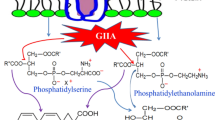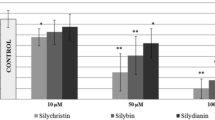Abstract
The interaction of retinoids and flavonoids with phospholipases A2 (PLA2) was studied to assess the mechanism of inhibition. Retinoids, such as retinal, retinol, retinoic acid and retinol acetate, and flavonoids, such as quercetin, rutin, morin and sciadopitysin, inhibit Ca2+-dependent PLA2 activity of human synovial fluid (HSF)in vitro in a dose-dependent fashion; ID50 s ranged from 2–8 μM. Retinal inhibited neutral active Ca2+-dependent PLA2s from human platelets, human plasma, human polymorphonuclear leukocytes andNaja mossambica mossambica venom in a dose-dependent manner while quercetin inhibits extracellular PLA2 activities of human plasma, HSF andN. m. mossambica venon in a dose-dependent manner but not PLA2 activity derived from human platelets and polymorphomonuclear leukocytes.
Inhibition of PLA2 activity by both flavonoid and retinoids were independent of Ca2+ or Na+. Increasing substrate concentration (9–144 nmols) relieved the inhibition of HSF-PLA2 activity by quercetin indicating probable interaction with the substrate. The inhibition by retinal is independent of substrate concentration suggesting that inhibition by retinal is probably due to direct interaction with the enzyme. both retinal and quercetin quenched the relative fluorescent intensity ofN. m. mossambica PLA2 and in a dose-dependent manner in the same concentration range at which they inhibitin vitro PLA2 activity. Retinal and quercetin shift the thermotropic phase transition of distearoylphosphatidylethanolamine (DSPE) liposomes. Both compounds broadened the transition peak, shifted theT m to lower temperature, and decreased enthalpy significantly. These findings indicate that inhibition of non-pancreatic human PLA2s by retinoids and flavonoids can be mediated by interaction with enzyme and/or substrate.
Similar content being viewed by others
References
C. Fiedler-Nagy, A. Georgiadis and J. W. Coffey,Effect of retinoids on arachidonic acid release and metabolism by rat peritoneal macrophages. Agents and Actions16, 620–621 (1985).
B. Havsteen,Flavonoids, a class of natural products of high pharmacological potency. Biochem. Pharm.32, 1141–1148 (1983).
E. Middleton, Jr.,The flavonoids, Trends Pharmacol. Sci.5, 335–338 (1984).
C. Marcelo, R. Bartel and J. Fortune,Effect of retinoids and glucocorticoids on phospholipase A 2 and C mediated release of arachidonic acid by murine keratinocyte culture. Clin. Res.34, 766A (1986).
M. J. Alcaraz and J. R. S. Hoult,Effects of hypolactin-8-glucoside and related flavonoids on soybean lipoxygenase and snake venom phospholipase A 2.Arch. Int. Pharmacodyn. 278, 4–12 (1985).
S. Rittenhouse-Simmons,Production of diglyceride from phosphatidylinositol in activated human platelets. J. Clin. Invest.63, 580–587 (1979).
F. A. Kuehl, Jr. and R. W. Egan,Prostaglandins, arachidonic acid, and inflammation. Science210, 978–984 (1980).
D. R. Robinson, D. P. Curran and P. J. Hamer,Prostaglandins and related compounds in inflammatory rheumatic diseases. InAdvances in Inflammation Research, vol. 3 (Eds. M. Ziff, G. P. Velo and S. Gorini) pp. 17–27, Raven Press, New York 1982.
R. J. Flower,The lipocortins and their role in controlling defence reactions. InAdvances in Prostaglandin, Thromboxane and Leukotriene Research, vol. 15. (Eds. O. Hayaishi and S. Yamamoto) pp. 201–203, Raven Press, New York 1985.
R. C. Franson, D. Eisen, R. Jesse and C. Lanni, Inhibition of highly purified mammalian phospholipase A2 by nonsteroidal anti-inflammatory agents, modulation by calcium ions. Biochem. J.186, 633–636 (1980).
P. Vadas,The efficacy of anti-inflammatory agents with respect to extracellular phospholipase A 2 activity. Life sciences30, 155–162 (1982).
A. A. Fawzy and R. C. Franson,Purification and characterization of human synovial fluid phospholipase A 2.Biophys. J. 49, 533 a (1986).
R. Jesse and R. C. Franson,Effects of highly purified platelet and granulocyte phospholipase A 2 on human platelet function. Clin. Res 27, 298 A (1979).
R. Jesse and R. Franson,Modulation of purified phospholipase A 2 activity from human platelets by calcium and indomethacin. Biochim. Biophys. Acta575, 467–470 (1979).
F. Marki and R. Franson,Endogenous suppression of neutralactive and calcium-dependent phospholipase A 2 in human polymorphonuclear leukocytes. Biochim. Biophys. Acta879. 149–156 (1986).
R. C. Franson, P. Patriarca, and P. Elsbach,Phospholipid metabolism by phagocytic cells. Phospholipase A 2 associated with rabbit polymorphonuclear leukocte granules. J. Lipid Res.15, 380–388 (1974).
M. M. Bradford,A rapid and sensitive method for the quantitation of microgram quantities of protein utilizing the principle of protein-dye binding. Anal. Biochem.72, 248–254 (1976).
B. S. Vishwanath, R. M. Kini and T. V. Gowda,Characterization of three edema-inducing phospholipase A 2 from habu (Trimeresurus flavoviridis) venom and their interaction with the alkaloid aristolochic acid. Toxicon25, 501–515 (1987).
T. P. Lee, M. L. Matteliano and E. middleton, Jr.,Effect of quercetin on human polymorphonuclear leukocyte lysosomal enzyme release and phospholipid metabolism. Life Sciences31, 2765–2774 (1982).
M. F. Roberts, R. A. Deems, T. C. Mincey, and E. A. Dennis,Chemical modification of the histidine residue in phospholipase A 2 (Naja naja naja). A case of half-site reactivity. J. Biol. Chem.252, 2405–2411 (1977).
E. Vallee, J. Gougat, J. Navarro and J. F. Delahayes,Antiinflammatory and platelet anti-aggregant activity of phospholipase A 2 inhibitors. J. Pharm. Pharmacol.31, 588–592 (1979).
A. J. Seppala, N.-E. L. Saris and M. L. Gauffin,Inhibition of phospholipase A-induced swelling of mitochondria by local anesthetics and related agents. Biochem. Pharmacol.20, 305–313 (1971).
F. F. Davidson, E. A. Dennis, M. Powell, and J. R. Glenney, Jr.,Inhibition of phospholipase A 2 by “Lipocortins” and calpactins. An effect of binding to substrate phospholipids. J. Biol. Chem.262, 1698–1705 (1987).
C. A. Langsford, M. R. Albrecht, T. M. Phelps, W. Stillwell and S. R. Wassall,Biophysical studies of retinoidphospholipid interactions. Biophys. J.51, 239a (1987).
R. D. Klausner, A. M. Kleinfeld, R. L. Hoover and M. J. Karnovsky,Lipid domains in membranes. Evidence derived from structural perturbations induced by free fatty acids and lifetime heterogeneity analysis. J. Biol. Chem.255, 1286–1295 (1980).
L. R. Ballou and W. Y. Cheung,Inhibition of human platelet phospholipase A 2 activity by unsaturated fatty acids. Proc. Natl. Acad. Sci. USA82, 371–375 (1985).
Author information
Authors and Affiliations
Rights and permissions
About this article
Cite this article
Fawzy, A.A., Vishwanath, B.S. & Franson, R.C. Inhibition of human non-pancreatic phospholipases A2 by retinoids and flavonoids. Mechanism of action. Agents and Actions 25, 394–400 (1988). https://doi.org/10.1007/BF01965048
Received:
Accepted:
Issue Date:
DOI: https://doi.org/10.1007/BF01965048




